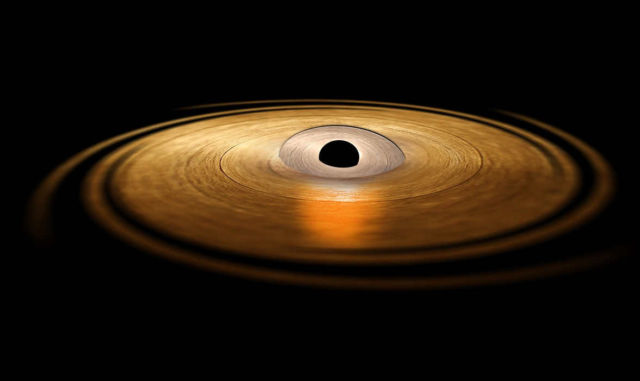Astronomers has detected matter wobbling around a black hole for the first time.
Matter falling into a black hole heats up as it plunges to its doom. Before it passes into the black hole and is lost from view forever, it can reach millions of degrees. At that temperature it shines X-rays into space.
Above, this artist’s impression depicts the accretion disc surrounding a black hole, in which the inner region of the disc precesses. “Precession” means that the orbit of material surrounding the black hole changes orientation around the central object. Credits: ESA/ATG medialab
The European Space Agency’s orbiting X-ray observatory, XMM-Newton, has proved the existence of a “gravitational vortex” around a black hole. The discovery, aided by NASA’s Nuclear Spectroscopic Telescope Array (NuSTAR) mission, solves a mystery that has eluded astronomers for more than 30 years, and will allow them to map the behavior of matter very close to black holes. It could also open the door to future investigations of Albert Einstein’s general relativity.
In the 1980s, pioneering astronomers using early X-ray telescopes discovered that the X-rays coming from stellar-mass black holes in our galaxy flicker. The changes follow a set pattern. When the flickering begins, the dimming and re-brightening can take 10 seconds to complete. As the days, weeks and then months progress, the period shortens until the oscillation takes place 10 times every second. Then, the flickering suddenly stops altogether.
The phenomenon was dubbed the Quasi Periodic Oscillation (QPO). “It was immediately recognized to be something fascinating because it is coming from something very close to a black hole,” said Adam Ingram, University of Amsterdam, the Netherlands, who began working to understand QPOs for his doctoral thesis in 2009.
During the 1990s, astronomers had begun to suspect that the QPOs were associated with a gravitational effect predicted by Einstein’s general relativity: that a spinning object will create a kind of gravitational vortex.
“It is a bit like twisting a spoon in honey. Imagine that the honey is space and anything embedded in the honey will be “dragged” around by the twisting spoon,” explained Ingram. “In reality, this means that anything orbiting a spinning object will have its motion affected.” In the case of an inclined orbit, it will “precess.” This means that the whole orbit will change orientation around the central object. The time for the orbit to return to its initial condition is known as a precession cycle.
source NASA






Leave A Comment